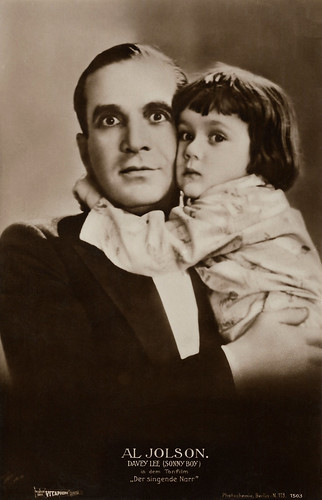
German postcard by Photochemie, Berlin, no. 1503. Photo: Warner Bros Vitaphone. Al Jolson and Davey Lee in The Singing Fool (Lloyd Bacon, 1928).
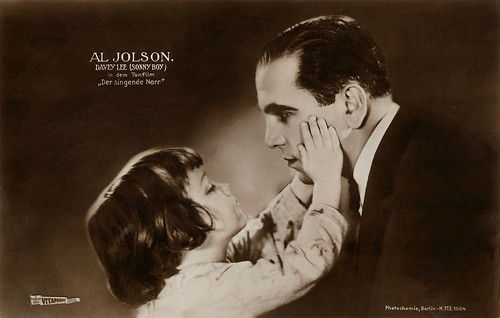
German postcard by Photochemie, Berlin, no. 1504. Photo: Warner Bros Vitaphone. Al Jolson and Davey Lee in The Singing Fool (Lloyd Bacon, 1928).
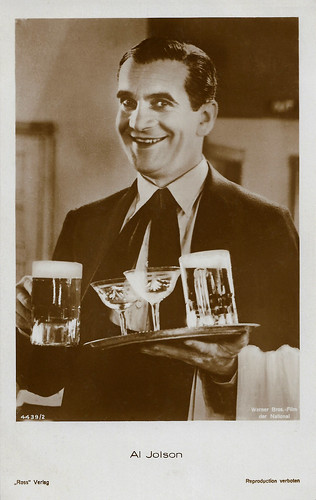
German postcard by Ross Verlag, no. 4439/2. Photo: Warner Bros. Film. Al Jolson in The Singing Fool (Lloyd Bacon, 1928), in which Jolson plays a singing waiter and wears the same outfit.
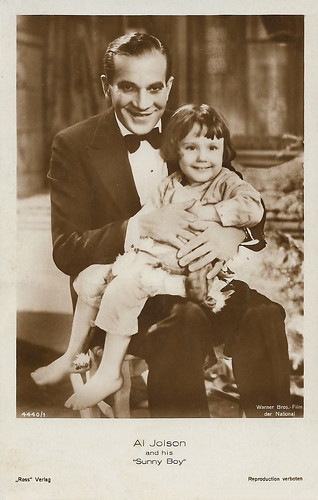
German postcard by Ross Verlag, no. 4440/1, 1929-1930. Photo: Warner Bros. / National. Al Jolson and his 'Sunny Boy' (Davey Lee) in The Singing Fool (Lloyd Bacon, 1928).
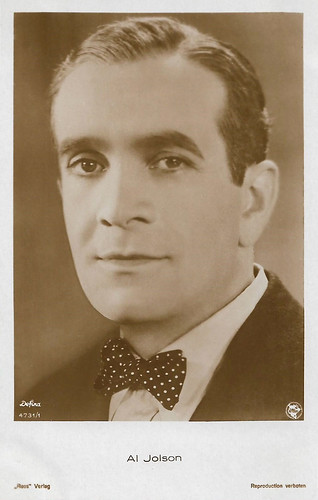
German postcard by Ross Verlag, no. 4731/1, 1929-1930. Photo: Defina / First National.
The one-knee performance
Al Jolson was born Asa Yoelson in 1886 in Seredžius (Srednik), Kovno Governorate, Russia, now Lithuania. He was the youngest son of a strictly religious Jewish cantor, Moise Rubin Yoelson, and his wife Naiomi Etta. To escape poverty and anti-Semitism, the family emigrated to the USA to Washington (D.C.) around 1894. Shortly after their arrival, his mother died after a short, violent illness.
When his father remarried soon afterwards, Jolson fled with his older brother, Harry, from the parental home to New York and made his way as a singer and shoeshine boy. He performed on various theatrical stages in mostly poor neighbourhoods and entertained the troops headed for the Spanish-American War. He also lived for some time on the streets and in an orphanage. He was signed eventually by Lew Dockstaders' Minstrels.
Joseph Ciolino at IMDb: "It is important to note that, although performing in blackface, Dockstader's was not a minstrel show in the traditional sense of the "Tambo and Bones" variety of the previous century. It was a sophisticated, topical, Broadway-style revue. The myth lingers to this day that Jolson was a minstrel. He most certainly was not." He developed a stage-filling and audience-engaging gesture or interaction, especially playing with his eyes (eye-rolling and the like), artful whistling and an operatic singing style in a musical jazz context. Jolson's stay in vaudeville was relatively short. In 1911, Jolson was just 25, he made his breakthrough. Against the wishes of the producers, he expanded his part in the Broadway musical 'La Belle Parée', which had been intended as a supporting role, into a leading role.
His talent was quickly recognised by the Shubert Brothers, who signed him to appear in the opening show of their new Winter Garden Theater on Broadway in April of 1912. Thus began what many consider to be the greatest career in the history of Broadway. The audience loved his style and his performances. He appeared as a star in various Broadway shows until the mid-1920s. The sales of his records reached high figures for the time. In 1920, Jolson recorded a song by 20-year-old George Gershwin: 'Swanee'. It immediately became a huge hit, giving the composer and singer great fame in America and Europe. One of his central musical trademarks emerged during the Vaudeville era: the "one-knee performance", in which Jolson knelt on one leg and sang 'My Mammy'. He later kept trying out different songs in which he sang about the figure of the mother. Al Jolson is best known for his performance in the film The Jazz Singer (Alan Crosland, 1927) with May McAvoy.
Film producer Jack L. Warner approached Jolson for the starring role in this - coincidentally - essentially autobiographical film. By not sticking to the script and improvising short, typical dialogues between the singing scenes against the wishes of the producers, Jolson paved the way for the talkies. For this reason, The Jazz Singer is considered the first commercially successful sound film ever. Jolson waived his fee for this film, which no one expected to be such a success because Warner Bros. was on the verge of bankruptcy. Against all expectations, he earned almost one million US dollars from this film - and Warner Brothers was saved. Before that, Jolson had already had two other film offers one of which he realised, A Plantation Act (Philip Roscoe, 1926), a film in which Warner Bros. was already trying out the Vitaphone technique. He abandoned the other film in the middle of production because he found it hard to bear working with the camera instead of the audience and because he thought he looked like a zebra on the screen.
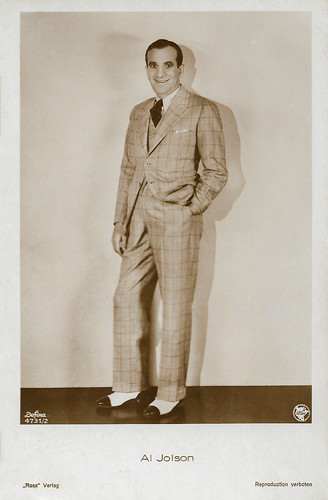
German postcard by Ross Verlag, no. 4731/2, 1929-1930. Photo: Defina / First National.
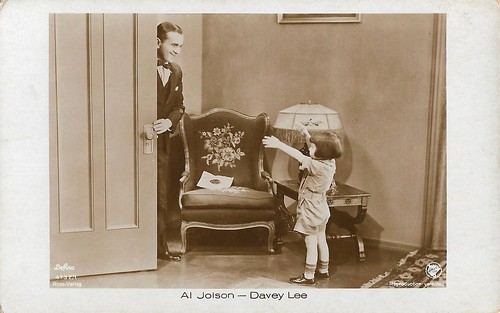
German postcard by Ross Verlag, no. 4732/1, 1929-1930. Photo: Defina / First National. Davey Lee and Al Jolson in Say It with Songs (Lloyd Bacon, 1929).
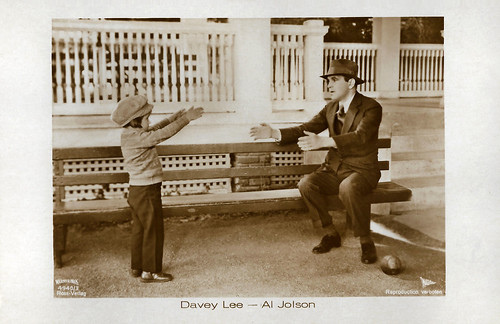
German postcard by Ross Verlag, no. 4940/3, 1929-1930. Photo: Warner Bros / National. Davey Lee and Al Jolson in Say It with Songs (Lloyd Bacon, 1929).
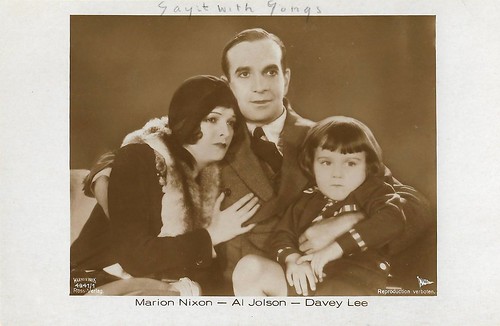
German postcard by Ross Verlag, no. 4941/1, 1929-1930. Photo: Warner Bros / National. Al Jolson, Marion Nixon and Davey Lee in Say It With Songs (Lloyd Bacon, 1929).
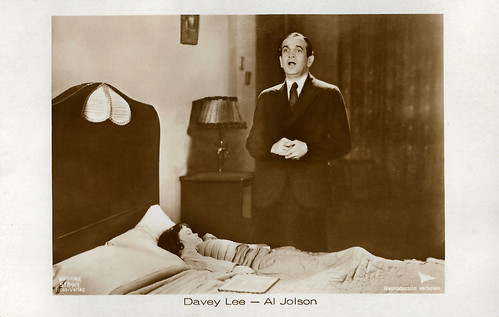
German postcard by Ross Verlag, no. 5189/1.1930-1931. Photo: Warner Bros / National. Al Jolson and Davey Lee in Say It with Songs (Lloyd Bacon, 1929). In his dreams, the boy sees and hears his father singing 'Little Pal' to him. The superimposition used in the film is absent on this card.
The most successful film ever until Gone with the Wind
A year after The Jazz Singer, Al Jolson made the film The Singing Fool (Lloyd Bacon, 1928) with Betty Bronson and Davey Lee, which broke the latter's records and remained the most successful film ever until Gone with the Wind (1939). In film terms, Jolson was now - after almost 20 successful Broadway years - at the peak of his career. He became an American institution, had contact with various presidents of the USA and occasionally dined at the White House.
After the success of The Jazz Singer, Jolson appeared in twelve more films, including Mammy (Michael Curtiz, 1930), Big Boy (Alan Crosland, 1930), and Hallelujah I'm a Bum (Lewis Milestone, 1933) with Madge Evans and Harry Langdon. His acting skills did not reach the quality he had as a live entertainer, yet most of his films were audience successes. His career on Broadway is unparalleled in length, nearly 30 years from 1911 to 1940, and in popularity.
Jolie, as he was called by his friends, was the first entertainer to sell a million records. However, Jolson on film was a pale version of Jolson on stage. His screen appearances, with some exceptions, are stiff and wooden. Audience tastes changed in the 1930s. Jolson's more classical singing was now seen as outdated and replaced by crooners. Younger musicians like Bing Crosby gradually became more successful. Jolson was already around 50. After leaving Broadway, Al Jolson turned to radio appearances and appeared in various shows both as a host and guest. These were always in the top 10. When the USA went into World War II, Jolson was the first major entertainer to complete a huge musical tour in support of the troops, with Marlene Dietrich among others. Jolson was almost 60 years old at the time and pushed himself to his physical limits on this tour. Jolson made a tremendous comeback when Columbia Pictures made a biographical film about Jolson, The Jolson Story (Alfred E. Green, 1946).
In this film, Larry Parks played the role of Jolson, but the songs were sung by Jolson himself. It was the surprise smash hit of the season and the highest-grossing film of the year. Parks received an Academy Award nomination for Best Actor. Jolson was now as big, or bigger than ever. So successful was the film that Columbia made a sequel, Jolson Sings Again (Henry Levin, 1949), which remains one of a few biography sequels in film history. It led to a whole new generation being captivated by Jolson's voice and charisma. His most successful radio show was Kraft Music Hall in the late 1940s. All the show stars of the time (from Bing Crosby and Cary Grant to Humphrey Bogart and Doris Day) appeared on this show. The permanent partner in this show was the pianist, Oscar Levant. In 1948, Jolson was named the most popular male vocalist in a poll. He died in 1950 in San Francisco and is buried in the Slope Memorial Park Cemetery in Culver City, California.
On 23 October, the day he died, to honour him, the lights on Broadway were turned off for 10 minutes. Al Jolson was married four times, often neglecting his wives and launching serious rescue attempts only when it was too late. His first wife, Henrietta Keller, divorced him after almost twelve years (1907-1919). His second marriage to Ethel Delmar (1922-1926), ended with a flash divorce in Paris and Ethel's incarceration in an asylum for alcoholics. With his third wife, the dancer and actress Ruby Keeler (1928-1939), Jolson adopted his first son Al Jolson Jr. He was unable to develop a close relationship with the boy, which pained the child-loving Jolson greatly. This period was marked by his declining star, and he was extremely jealous of his wife's success. They separated in 1939. It was not until his fourth marriage (1940-1950) to Erle Galbraith, a US military X-ray technician 39 years his junior, that he was happy, thanks in part to the grandiose fame of his last years and the fact that she was no professional competition for him. With her, he adopted another boy in 1948, whom they named Asa, and a girl named Alicia in 1950.
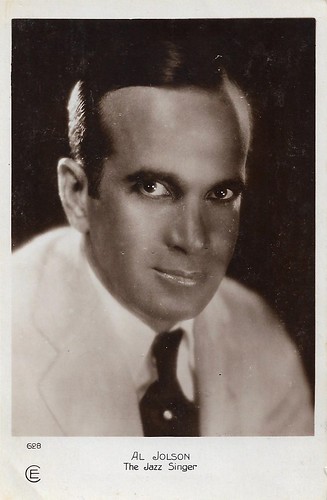
French postcard by Cinémagazine-Edition, no. 628. Al Jolson in the early sound film The Jazz Singer (Alan Crossland, 1927). Although the film had its American premiere in New York on 6 October 1927, its general American release was months after, in February 1928. The film came out in France in October 1929, according to IMDb.
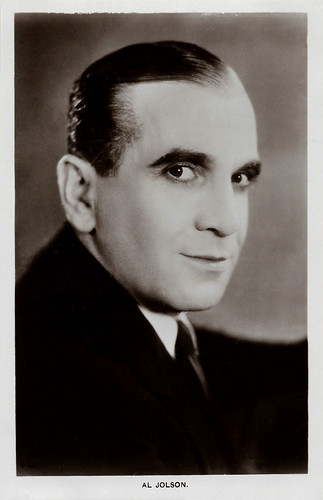
British postcard in the Picturegoer Series, London, no. 394.

Belgian postcard by S. A. Cacao et Chocolat Kivou, Vilvorde/ N. V. Cacao en Chocolade Kivou, Vilvoorde. Probably for The Singing Fool (Lloyd Bacon, 1928) in which Jolson wears the same tie.
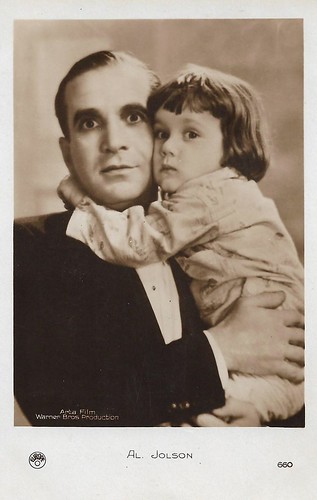
French postcard by Europe, no. 660. Photo: Arta Film. /Warner Bros. Production. Al Jolson and Davey Lee in The Singing Fool (Lloyd Bacon, 1928). In France, the film came out in December 1929.
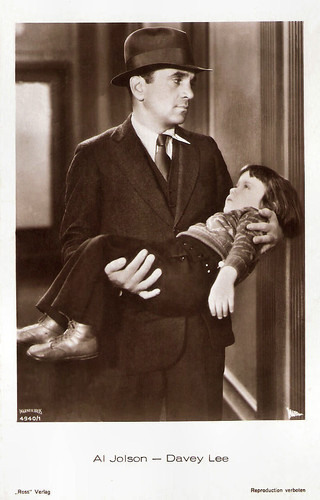
German postcard by Ross Verlag, no. 4940/1, 1929-1930. Photo: Warner Bros. / National. Al Jolson and Davey Lee in The Singing Fool (Lloyd Bacon, 1928).
Sources: Joseph Ciolino (IMDb), Wikipedia (Dutch and German), and IMDb.
This post was last updated on 25 November 2024.
No comments:
Post a Comment